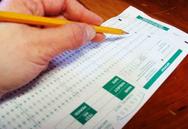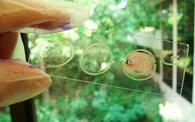 | ||||
Bacterial Cell Wall & Differential Staining
Practice Test Questions
XX
Virtual Microbiology Classroom of Science Prof Online
Bacterial Cell Wall Sample Test Questions
These multiple choice and true/false questions are designed to help students better understand this lecture topic.
Page last updated: 2/2016
SPO VIRTUAL CLASSROOMS
 | ||||||
1. Cells that retain the primary stain after undergoing Gram staining will be what color?
a. colorless
b. purple
c. pink
d. green
e. both pink and purple
2. Cells that retain the counterstain after undergoing acid-fast staining are considered to be:
a. nonacid-fast b. Gram - c. acid-fast d. Gram + e. Mycobacterium
3. Which type of bacterial cell wall has the most peptidoglycan?
a. Gram-positive b. Gram-negative c. both G+ and G- have same amount
4. Acid-fast bacteria are unique because their cell wall contains...
a. peptidoglycan b. LPS c. mycolic acid d. DNA e. granules
5. Ability to produce betalactamase helps bacteria resist...
a. heat b. chemical disinfectants c. certain anitbiotics d. LPS
The following questions, from the Virtual Microbiology Classroom, are designed to help students better understand this topic. All questions are based on material that can be found on the Bacterial Cell Wall & Differential Staining Lecture Main Page.
You have free access to a large collection of materials used in a college-level introductory microbiology course. The Virtual Microbiology Classroom provides a wide range of free educational resources including PowerPoint Lectures, Study Guides, Review Questions and Practice Test Questions.
6. Which type of bacteria would be an appropriate negative control for Gram-staining?
a. Staphylococcus aureus
b. Staphylococcus epidermidis
c. Streptococcus mutans
d. Escherichia coli
e. Bacillus subtilis
7. Which type of bacteria is penicillin effective against?
8. Which type of cell wall contains an endotoxin?
a. Gram-positive b. Gram-negative c. acid-fast d. non acid fast
9. The mordant used is Gram staining ...
a. kills the bacteria
b. helps bacteria stick to the slide
c. traps the primary stain in the bacterial cell wall
d. traps the counterstain in the bacterial cell wall
e. removes the primary stain from the cell wall
10. The acid alcohol in the acid-fast staining procedure ...
a. kills the bacteria
b. removes the secondary stain from the bacterial cell wall
c. traps the primary stain in the bacterial cell wall
d. traps the counterstain in the bacterial cell wall
e. removes the primary stain from the bacterial cell wall




